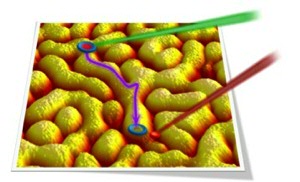Looking Inside Organic Solar Cells

Organic solar cells form an emerging area of photovoltaics, which promises to substitute traditional silicon solar modules for niche applications. To convert the sun energy into electricity in such a device, a bulk heterojunction is used, which is a phase-separated mixture of donor- and acceptor-type organic semiconductors. Achieving the highest power conversion efficiencies requires thorough control of the nanoscale structure of the bulk heterojunction, the so-called morphology. As the typical phase separation of the two materials occurs in 10 nm region, the morphology is extremely hard to study by conventional microscopic techniques.
The Optical Condensed Matter Physics and Polymer Science groups at the Zernike Institute for Advanced Materials have recently developed an all-optical method to determine key information on the morphology of the bulk heterojunction. Using a combination of ultrafast spectroscopy and kinetic Monte-Carlo simulations, they captured morphology features with nanometer spatial resolution. Independent verification of morphology reconstruction by microscopic and surface-sensitive X-ray scattering techniques demonstrated the validity of the all-optical approach. As the proposed technique is non-invasive, it can be used for on-the-fly characterization of fully functional devices thereby opening exciting perspectives for developing high-efficient organic optoelectronics.
The results of this work are published in
Serbenta, A. et al. Bulk heterojunction morphology of polymer:fullerene blends revealed by ultrafast spectroscopy. Sci. Rep. 6, 36236; doi: 10.1038/srep36236 (2016)
More news
-
15 September 2025
Successful visit to the UG by Rector of Institut Teknologi Bandung
